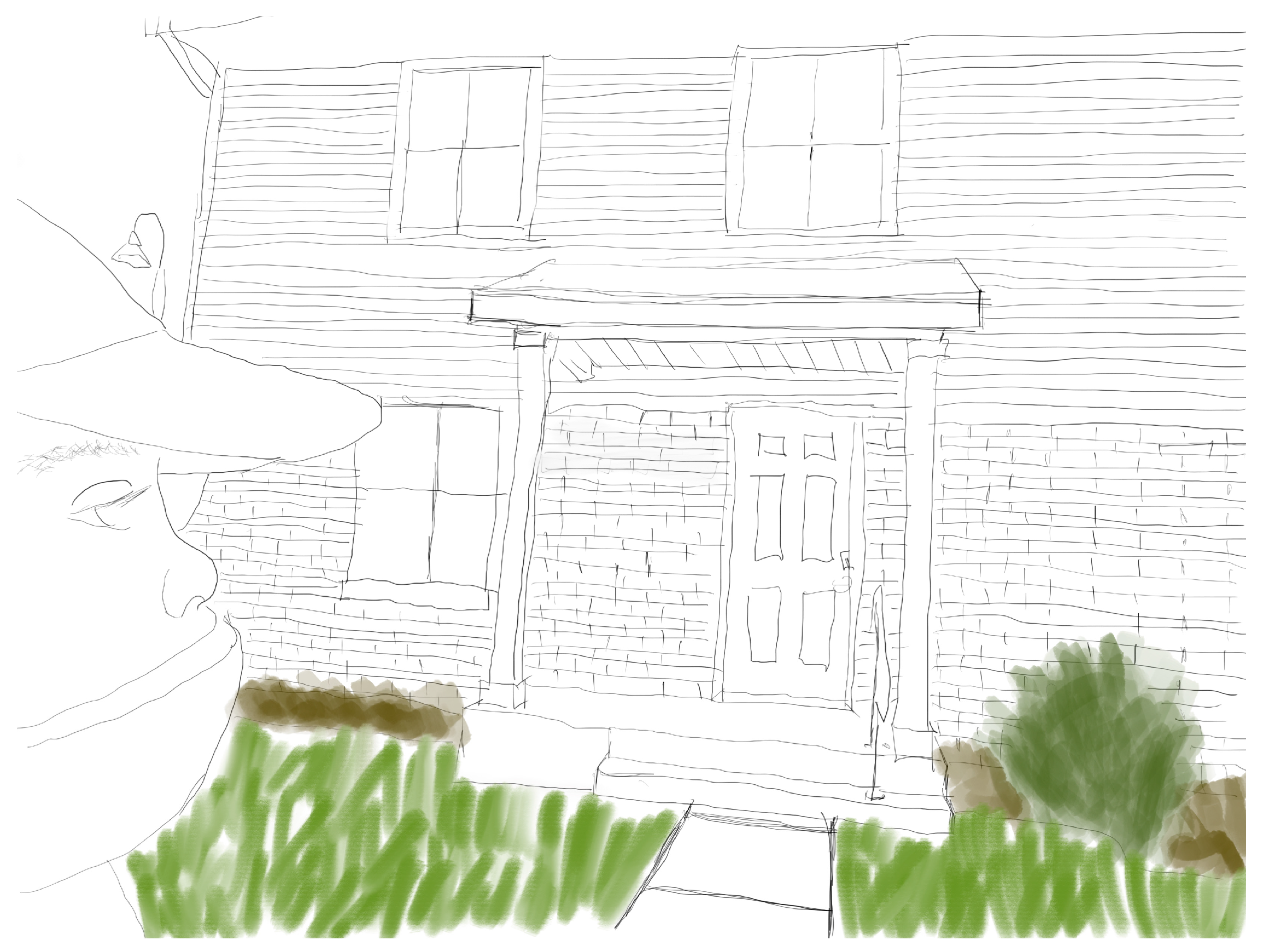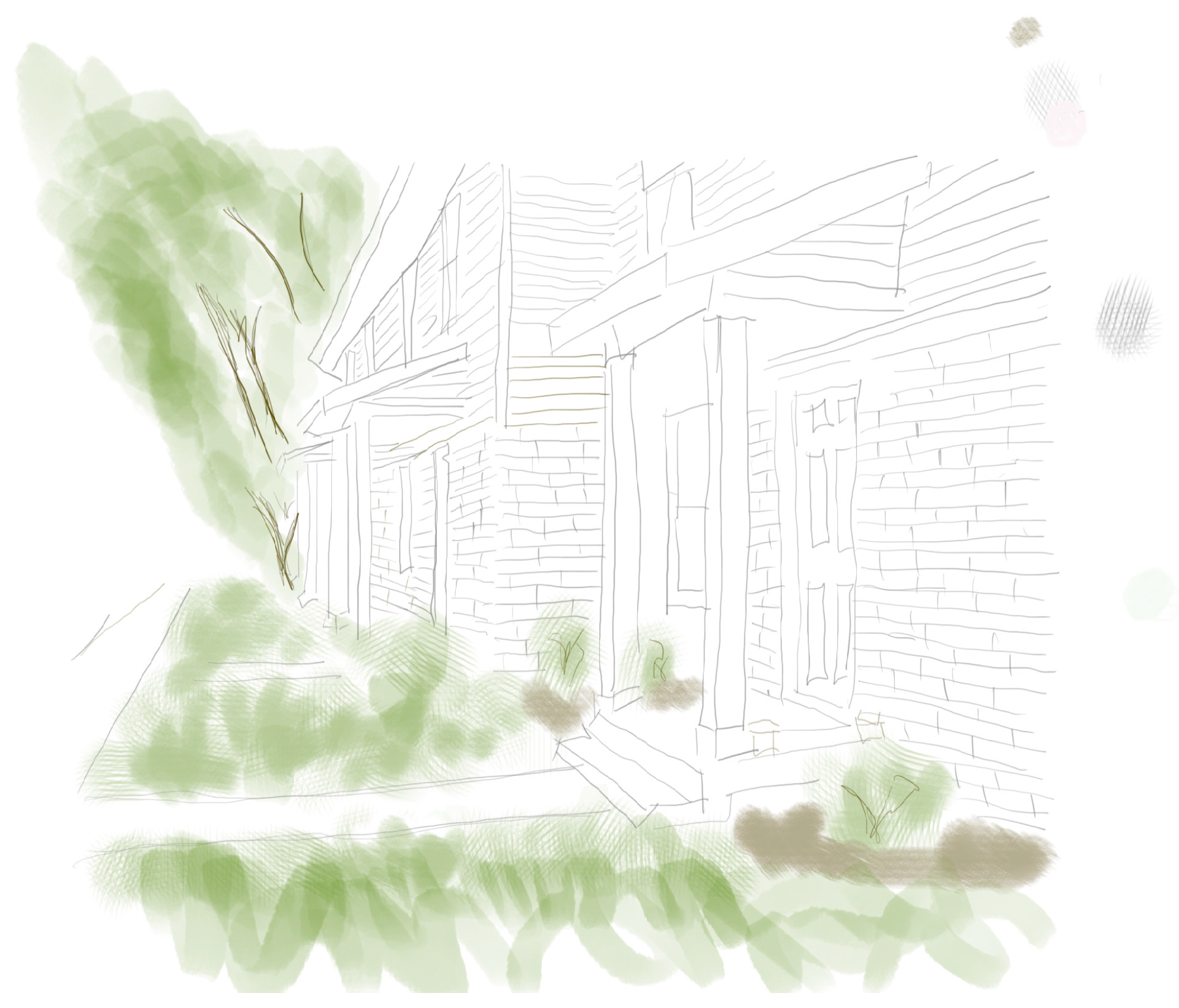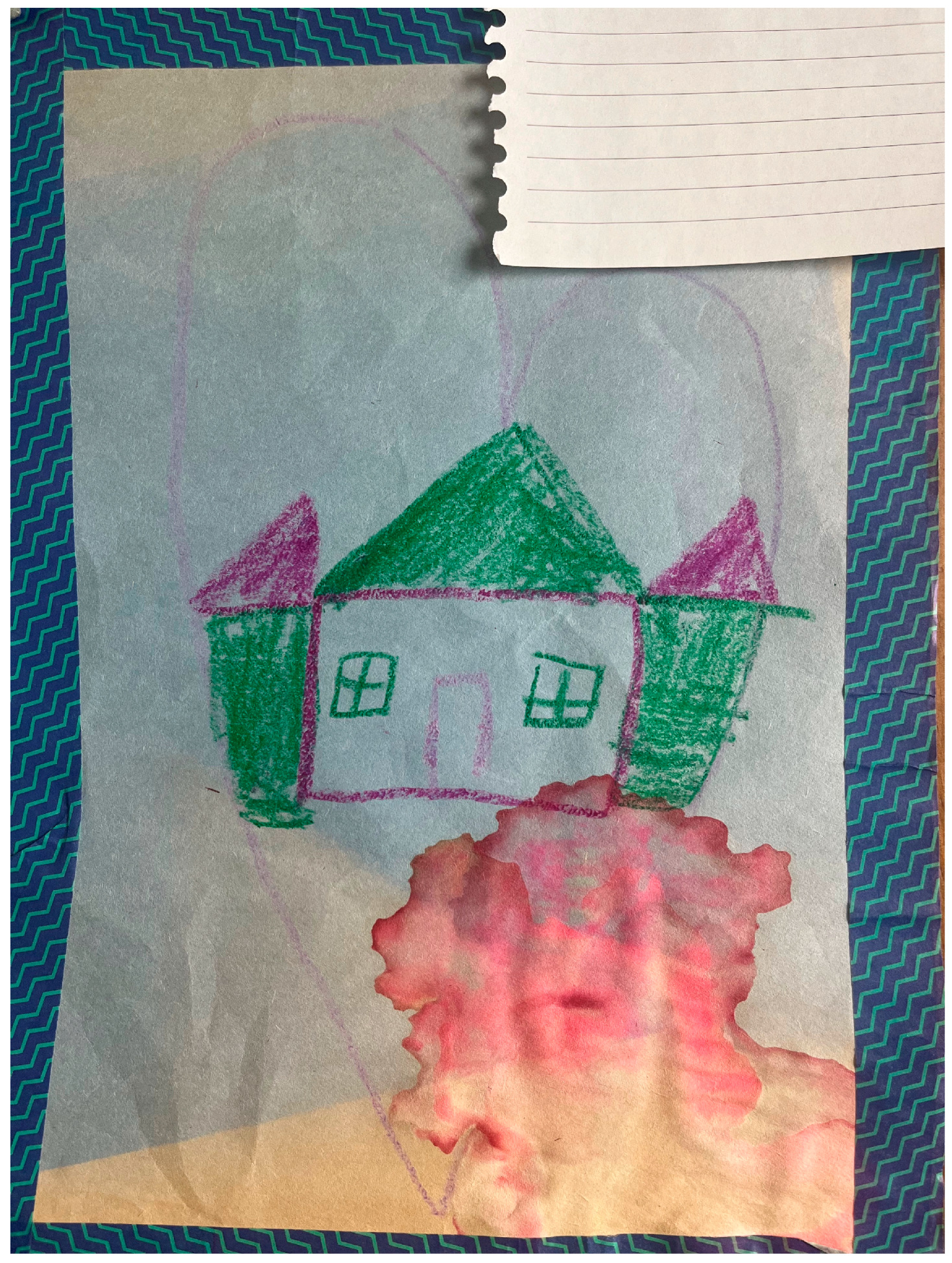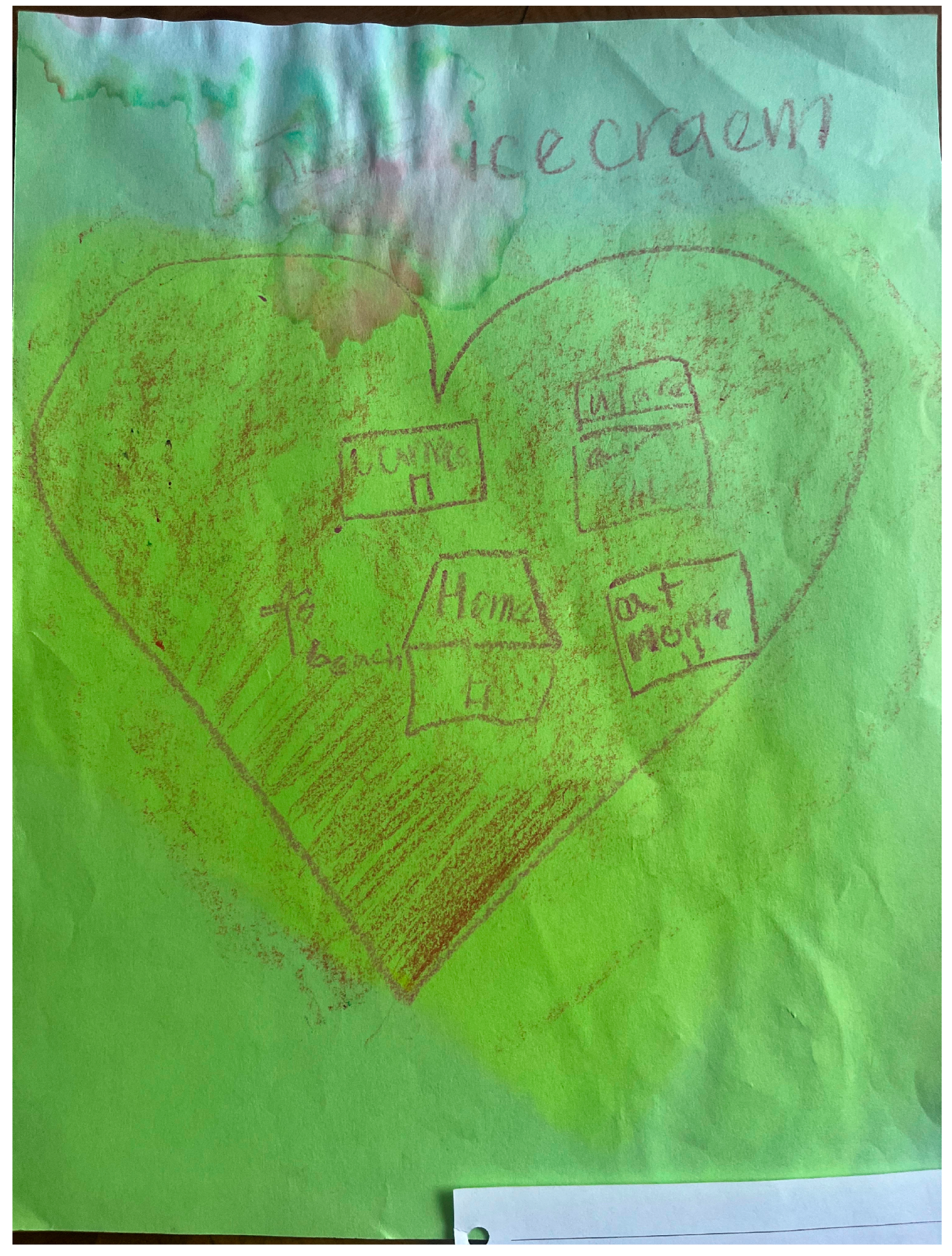Maps, Movement, and Meaning: Children Restorying Thresholds with Heart Maps and Walking Tours as Acts of Spatial Reclamation
Abstract
“If we address stories as archaeological sites, and dust through their layers with meticulous care, we find at some level there is always a doorway. A dividing point between here and there, us and them, mundane and magical. It is at the moments when the doors open, when things flow between the worlds, that stories happen.”(Harrow, 2019).
1. Conceptual Framework: Spatial Reclamation
Relevant Literature
2. Materials and Methods
2.1. Participants and Location
2.2. Analytic Focus
3. Results
3.1. Hegemonic Stories of Limestone Quarry
3.2. Sisters Spatially Reclaim Stories of Place: Heart Maps
3.3. Heart Maps
3.4. Walking Tour: Aniyah and Aliyah Reclaim Home Through Stories
4. Discussion
5. Conclusions
Funding
Institutional Review Board Statement
Informed Consent Statement
Data Availability Statement
Acknowledgments
Conflicts of Interest
References
- Adichie, C. N. (2009). The danger of a single story. Chimamanda Ngozi Adichie: The danger of a single story|TED talk. Available online: https://www.ted.com/talks/chimamanda_ngozi_adichie_the_danger_of_a_single_story/c (accessed on 18 June 2025).
- Anderson, S. (2006). Imagined communities. Literary Criticism and Cultural Theory, 49. [Google Scholar]
- Anyon, J. (1980). Social class and the hidden curriculum of work. Journal of Education, 162(1), 67–92. [Google Scholar] [CrossRef]
- Bhattacharya, K. (2017). Fundamentals of qualitative research: A practical guide. Routledge. [Google Scholar]
- Bourdieu, P. (1991). Language and symbolic power. Harvard University Press. [Google Scholar]
- Dovey, K. (2009). Becoming places: Urbanism/architecture/identity/power. Routledge. [Google Scholar]
- Ellsworth, E. (2005). Places of learning: Media, architecture, pedagogy. Routledge. [Google Scholar]
- Gee, J. P. (2015). Discourse, small d, big D. The International Encyclopedia of Language and Social Interaction, 3, 1–5. [Google Scholar]
- Goffman, E. (1983). The interaction order: American Sociological Association, 1982 presidential address. American Sociological Review, 48(1), 1–17. [Google Scholar] [CrossRef]
- Halpern, R. (2003). Making play work: The promise of after-school programs for low-income children. Teachers College Press. [Google Scholar]
- Harrow, A. E. (2019). The ten thousand doors of january. Redhook. [Google Scholar]
- Heard, G. (2016). Heart maps: Helping students create and craft authentic writing. Heinemann. [Google Scholar]
- Heard, G. (2018). Mapping your heart|Georgia Heard|TEDxTheBenjaminSchool. YouTube. Available online: https://www.youtube.com/watch?v=dyYDzDHV_As (accessed on 17 May 2018).
- Hillsdale Midwest History. (1979). State & county history. Retrieved May 11, 2020.
- Hillsdale Newspaper. (1986). Hillsdale herald.
- Hunt, D. B. (2009). Blueprint for disaster: The unraveling of Chicago public housing. University of Chicago Press. [Google Scholar]
- Jones, S., Thiel, J. J., Dávila, D., Pittard, E., Woglom, J. F., Zhou, X., Brown, T., & Snow, M. (2016). Childhood geographies and spatial justice: Making sense of place and space-making as political acts in education. American Educational Research Journal, 53(4), 1126–1158. [Google Scholar] [CrossRef]
- Jones, S., & Vagle, M. D. (2013). Living contradictions and working for change: Toward a theory of social class–sensitive pedagogy. Educational Researcher, 42(3), 129–141. [Google Scholar] [CrossRef]
- Kim, J. H. (2015). Understanding narrative inquiry: The crafting and analysis of stories as research. Sage Publications. [Google Scholar]
- Leander, K. M., & Sheehy, M. (Eds.). (2004). Spatializing literacy research and practice (Vol. 15). Peter Lang. [Google Scholar]
- Luke, A. (1992). The body literate: Discourse and inscription in early literacy training. Linguistics and Education, 4(1), 107–129. [Google Scholar] [CrossRef]
- Massey, D. B. (2009). Space, place, and gender. University of Minnesota Press. [Google Scholar]
- Moje, E. B. (2004). Powerful spaces: Tracing the out-of-school literacy spaces of Latino/a youth. In K. M. Leander, & M. Sheehy (Eds.), Spatializing literacy research & practice (pp. 15–37). Peter Lang. [Google Scholar]
- Moje, E. B., Ciechanowski, K. M., Kramer, K., Ellis, L., Carrillo, R., & Collazo, T. (2004). Working toward third space in content area literacy: An examination of everyday funds of knowledge and discourse. Reading Research Quarterly, 39(1), 38–70. [Google Scholar] [CrossRef]
- Nasheeda, A., Abdullah, H. B., Krauss, S. E., & Ahmed, N. B. (2019). Transforming transcripts into stories: A multimethod approach to narrative analysis. International Journal of Qualitative Methods, 18, 1609406919856797. [Google Scholar] [CrossRef]
- Panos, A., Wessel-Powell, C., Weir, R., & Pennington, C. (2021). Waypoints for literacy researchers: Boundary tracing, historicizing, and enacting critical equity literacies. International Studies in Sociology of Education, 31(1–2), 80–103. [Google Scholar] [CrossRef]
- Peele-Eady, T. B., & Moje, E. B. (2020). Communities as contexts for learning. In Handbook of the cultural foundations of learning (pp. 230–246). Routledge. [Google Scholar]
- Perry, M., & Medina, C. (2011). Embodiment and performance in pedagogy research: Investigating the possibility of the body in curriculum experience. Journal of Curriculum Theorizing, 27(3), 62–75. [Google Scholar] [CrossRef]
- Pineau, E. L. (2002). Critical performative pedagogy: Fleshing out the politics of liberatory education. In N. Stucky, & C. Wimmer (Eds.), Teaching Performance Studies (pp. 41–54). Southern Illinois University Press. [Google Scholar]
- Rothstein, R. (2017). The color of law: A forgotten history of how our government segregated America. Liveright Publishing. [Google Scholar]
- Scollon, R., & Scollon, S. W. (2004). Nexus analysis: Discourse and the emerging internet. Routledge. [Google Scholar]
- Soja, E. W. (2010). Seeking spatial justice (Vol. 16). University of Minnesota Press. [Google Scholar]
- Stornaiuolo, A., & Thomas, E. E. (2018). Restorying as political action: Authoring resistance through youth media arts. Learning, Media and Technology, 43(4), 345–358. [Google Scholar] [CrossRef]
- Thomas, E. E., & Stornaiuolo, A. (2016). Restorying the self: Bending toward textual justice. Harvard Educational Review, 86(3), 313–338. [Google Scholar] [CrossRef]
- Trell, E. M., & Van Hoven, B. (2010). Making sense of place: Exploring creative and (inter) active research methods with young people. Fennia-International Journal of Geography, 188(1), 91–104. [Google Scholar]
- Tuan, Y. F. (1977). Space and place: The perspective of experience. U of Minnesota Press. [Google Scholar]
- Tuck, E., & McKenzie, M. (2014). Place in research: Theory, methodology, and methods. Routledge. [Google Scholar]
- Vasquez, V. M., Janks, H., & Comber, B. (2019). Critical literacy as a way of being and doing. Language Arts, 96(5), 300–311. [Google Scholar] [CrossRef]
- Walker, A., & Pennington, C. M. (2024). Bending stories, disrupting boundaries: Spatial reclamation as literacy practices beyond the rows and rules. Literacy, 58(3), 335–346. [Google Scholar] [CrossRef]
- Wang, C. C. (1999). Photovoice: A participatory action research strategy applied to women’s health. Journal of Women’s Health, 8(2), 185–192. [Google Scholar] [CrossRef] [PubMed]
- Wohlwend, K. (2021). Literacies that move and matter: Nexus analysis for contemporary childhoods. Routledge. [Google Scholar]
- Wohlwend, K. E. (2018). Child’s Play: Reading and Remaking Gendered Action Texts with Toys. In Literacies, sexualities, and gender (pp. 27–38). Routledge. [Google Scholar]




Disclaimer/Publisher’s Note: The statements, opinions and data contained in all publications are solely those of the individual author(s) and contributor(s) and not of MDPI and/or the editor(s). MDPI and/or the editor(s) disclaim responsibility for any injury to people or property resulting from any ideas, methods, instructions or products referred to in the content. |
© 2025 by the author. Licensee MDPI, Basel, Switzerland. This article is an open access article distributed under the terms and conditions of the Creative Commons Attribution (CC BY) license (https://creativecommons.org/licenses/by/4.0/).
Share and Cite
Pennington, C.M. Maps, Movement, and Meaning: Children Restorying Thresholds with Heart Maps and Walking Tours as Acts of Spatial Reclamation. Educ. Sci. 2025, 15, 834. https://doi.org/10.3390/educsci15070834
Pennington CM. Maps, Movement, and Meaning: Children Restorying Thresholds with Heart Maps and Walking Tours as Acts of Spatial Reclamation. Education Sciences. 2025; 15(7):834. https://doi.org/10.3390/educsci15070834
Chicago/Turabian StylePennington, Casey M. 2025. "Maps, Movement, and Meaning: Children Restorying Thresholds with Heart Maps and Walking Tours as Acts of Spatial Reclamation" Education Sciences 15, no. 7: 834. https://doi.org/10.3390/educsci15070834
APA StylePennington, C. M. (2025). Maps, Movement, and Meaning: Children Restorying Thresholds with Heart Maps and Walking Tours as Acts of Spatial Reclamation. Education Sciences, 15(7), 834. https://doi.org/10.3390/educsci15070834



